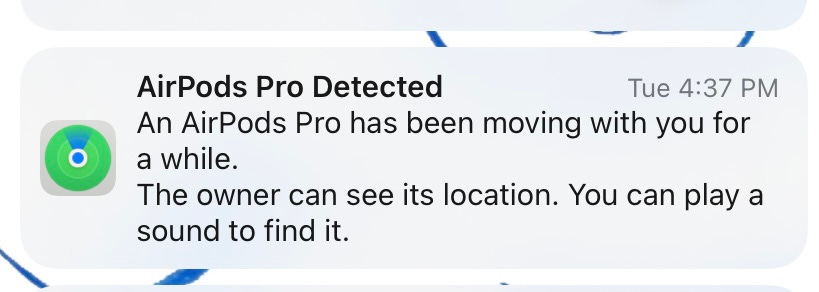My phone is stalking my boyfriend
Tech and social media have automated peer-to-peer surveillance.
Embedded is your essential guide to what’s good on the internet, from Kate Lindsay and Nick Catucci.🧩
I can be creepy all by myself, thank you very much. —Kate
Recently, my boyfriend finally got AirPods, upgrading not from wired earbuds, but the even more unsettling nothing that he would listen to while biking or running. Shortly after, my iPhone started giving me this alert:
The wording of this is meant to account for all kinds of possibilities: maybe you accidentally grabbed the wrong AirPods, maybe you stole them, or maybe, FYI, someone is following you. That someone, for me, is my live-in boyfriend, with whom, as you may imagine, I spend a not-insignificant amount of time.
Out to dinner, coming back from grocery shopping, or even just sitting around the apartment, I’ll randomly get this warning that I can’t help but picture being delivered ominously by someone who’s misread the vibe. “It’s okay,” I want to tell my phone. “I let him be near me this much on purpose.”
We all know that social media has introduced peer-to-peer surveillance into our daily lives. Not only are we documenting our habits and locations in real-time, but our use of the apps themselves—or even hardware, like AirPods—is sometimes its own valuable piece of information. If I start worrying that my boyfriend got into an accident on one of his various silent bike rides, rather than embarrass myself with my paranoia by texting him, I’ll sometimes check Instagram to see when he was last online, or how recently he liked a tweet. Phew, he liked this Justin Trudeau meme (?) from five minutes ago. He’s safe.
Another person I know (and who would kill me if I provided any more identifying information than that), has checked their partner’s location on Find My Friends so often that their phone now suggests they “Find [PARTNER’S NAME]” when they open their phone at a certain time every day. It’s the same neutral system picking up on when you most often open Instagram or text a friend, but it seems so sinister when it reveals a habit you perhaps don’t want to acknowledge in yourself.
Last week, Vanity Fair’s Delia Cai tweeted about a guy sending her a TikTok that, when she watched it, showed that the video had been sent to him by another woman, and linked to her account. And because TikTok tells you who views the videos you’ve shared, the woman likely also got a notification that Cai had watched the TikTok, too. This is a simple feature—like read receipts, but for seeing if your friends actually watch the videos you share in the group text—but in this instance, it created a narrative chain of events with potential consequences.

Online tools enable our nosiest romantic habits. I figured out that I was about to get dumped by casual fling years ago when he didn’t respond to my text, and I saw that he had been active on Tinder after I sent it. I checked Tinder specifically for that reason.
A little older and wiser now, I’ve decided it’s best to abstain from our readily-available surveillance tools in order to not hurt my own feelings. For instance, on Substack, I can go and see exactly who has and hasn’t read my posts—including my boyfriend and close friends. I’ve never done this, though, and don’t plan to, because despite it being available to me, having that information would probably hurt me more than it could ever help me. But there are other ways to find out if my boyfriend reads my newsletter—like, say, writing an entire post about it.





